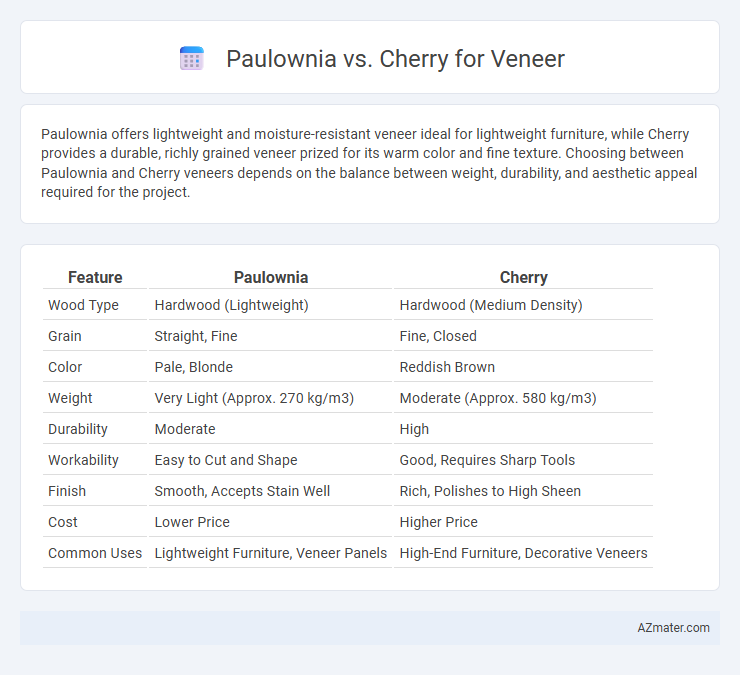Paulownia offers lightweight and moisture-resistant veneer ideal for lightweight furniture, while Cherry provides a durable, richly grained veneer prized for its warm color and fine texture. Choosing between Paulownia and Cherry veneers depends on the balance between weight, durability, and aesthetic appeal required for the project.
Table of Comparison
| Feature | Paulownia | Cherry |
|---|---|---|
| Wood Type | Hardwood (Lightweight) | Hardwood (Medium Density) |
| Grain | Straight, Fine | Fine, Closed |
| Color | Pale, Blonde | Reddish Brown |
| Weight | Very Light (Approx. 270 kg/m3) | Moderate (Approx. 580 kg/m3) |
| Durability | Moderate | High |
| Workability | Easy to Cut and Shape | Good, Requires Sharp Tools |
| Finish | Smooth, Accepts Stain Well | Rich, Polishes to High Sheen |
| Cost | Lower Price | Higher Price |
| Common Uses | Lightweight Furniture, Veneer Panels | High-End Furniture, Decorative Veneers |
Introduction to Veneer Woods: Paulownia vs Cherry
Paulownia and Cherry veneers differ significantly in density, grain, and workability, affecting their suitability for furniture and paneling. Paulownia offers a lightweight, pale veneer with a fine, straight grain that resists warping, ideal for applications requiring stability and a subtle aesthetic. Cherry veneer provides a rich, reddish-brown color with a smooth texture and natural luster, popular in high-end cabinetry and decorative surfaces due to its aging beauty and durability.
Botanical Overview of Paulownia and Cherry
Paulownia, a fast-growing hardwood from the Paulowniaceae family, features large, heart-shaped leaves and lightweight, pale wood prized for its dimensional stability and resistance to warping, making it ideal for veneer applications. Cherry, belonging to the Rosaceae family, is a slower-growing hardwood known for its rich, reddish-brown heartwood, fine grain, and smooth texture, offering a luxurious appearance and durability in veneer production. The botanical differences between Paulownia's broad-leafed, rapid biomass accumulation and Cherry's dense, fine-grained hardwood influence their respective veneer qualities, including weight, grain pattern, and finish potential.
Physical Appearance and Grain Patterns
Paulownia veneer exhibits a light, pale yellow to creamy-white color with a subtle, straight grain pattern that offers a clean, uniform appearance ideal for modern or minimalistic designs. Cherry veneer displays a rich, warm reddish-brown hue that deepens over time, featuring a fine, smooth texture with distinctive, wavy grain patterns and occasional small gum pockets for added character. The contrast between Paulownia's soft, understated look and Cherry's vibrant, dynamic grain patterns makes the latter more suitable for traditional or decorative applications.
Color Differences in Paulownia and Cherry Veneers
Paulownia veneer typically exhibits a pale, creamy to light brown color with subtle grain patterns, offering a soft and airy aesthetic ideal for modern and minimalist designs. Cherry veneer presents a rich reddish-brown hue that deepens over time, providing a warm, elegant appearance favored in traditional and upscale furniture. The color stability of Paulownia contrasts with Cherry's natural darkening process due to oxidation and light exposure, influencing design choices based on desired aging characteristics.
Workability: Cutting, Slicing, and Applying the Veneer
Paulownia veneer offers exceptional workability due to its lightweight, soft texture, and uniform grain, facilitating easy cutting and slicing with minimal tool wear. Cherry veneer, denser and harder, demands sharper tools and slower cutting speeds to achieve clean slices without splintering. Applying Paulownia veneer is streamlined by its flexibility and reduced risk of cracking, while cherry veneer requires careful handling and precise adhesive application to ensure a smooth, durable finish.
Durability and Longevity Comparison
Paulownia veneer is lightweight and mildly resistant to decay but generally offers lower durability compared to cherry veneer, which is known for its robust strength and long-lasting performance. Cherry's tight grain structure and natural oils contribute to superior resistance against wear, making it ideal for high-traffic or frequently used surfaces. Over time, cherry veneer maintains its structural integrity and aesthetic appeal better than Paulownia, ensuring greater longevity in furniture and cabinetry applications.
Weight and Density Considerations
Paulownia veneer is significantly lighter with a density around 0.28 g/cm3, making it ideal for applications requiring weight reduction, while cherry veneer is denser, approximately 0.55 g/cm3, offering enhanced durability and strength. The lower density of Paulownia contributes to easier handling and transportation but may compromise impact resistance compared to cherry. Choosing between Paulownia and cherry veneer hinges on balancing the need for lightweight materials against the preference for sturdier, denser wood surfaces.
Sustainability and Environmental Impact
Paulownia veneer stands out for its rapid growth rate, enabling sustainable harvesting cycles within 8 to 10 years, which significantly reduces deforestation pressure compared to cherry wood, which typically requires 30 to 40 years to mature. The lightweight nature of Paulownia lowers transportation emissions, enhancing its environmental profile, while cherry veneer production demands longer-term forest management, often impacting biodiversity. Paulownia's carbon sequestration capacity during growth also contributes positively to climate mitigation efforts, making it a more eco-friendly choice in veneer applications.
Cost Analysis: Paulownia vs Cherry Veneer
Paulownia veneer offers a significant cost advantage over cherry veneer due to its rapid growth rate and lower harvesting expenses, making it a more budget-friendly option for large-scale or cost-sensitive projects. Cherry veneer, prized for its rich color and fine grain, commands higher prices influenced by slower tree maturation and greater processing costs. When comparing long-term investments, Paulownia provides affordability without compromising too much on aesthetic appeal, whereas cherry veneer remains a premium choice with higher market value.
Best Uses and Applications for Each Veneer Type
Paulownia veneer offers lightweight durability ideal for furniture, cabinetry, and decorative paneling where a soft texture and consistent grain enhance aesthetics. Cherry veneer provides rich color and fine grain, preferred for high-end cabinetry, flooring, and musical instruments demanding a classic, warm finish. Both veneers excel in woodworking, but Paulownia suits moisture-resistant projects while Cherry suits applications requiring aging beauty and color depth.

Infographic: Paulownia vs Cherry for Veneer
 azmater.com
azmater.com